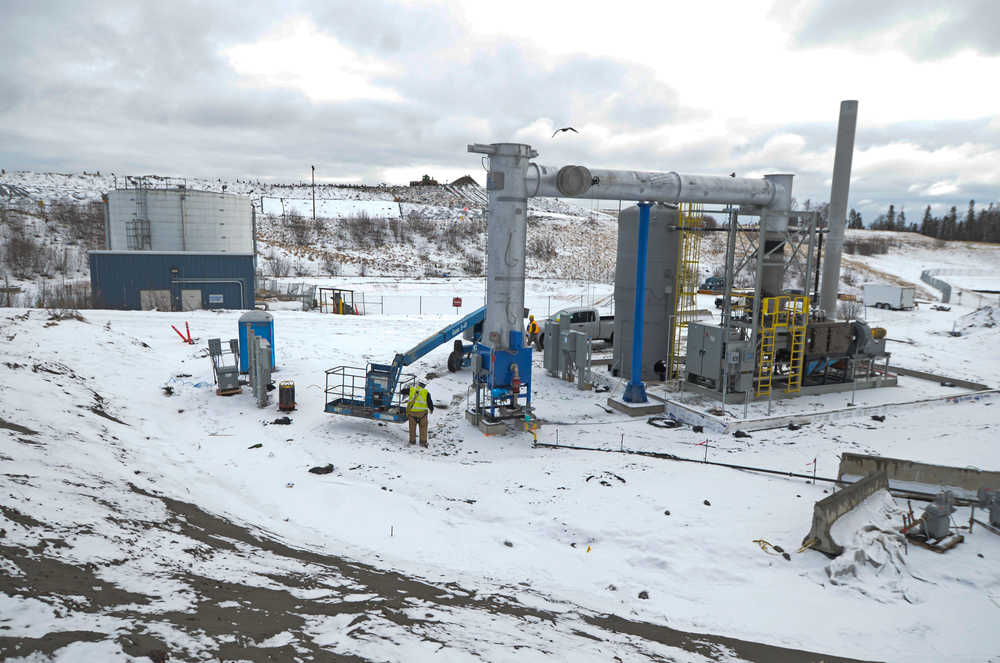Leachate. A liquid that forms when rain or snow comes in contact with waste and, if it isn’t collected and disposed of, can seep into the environment.
While the Kenai Peninsula Borough Solid Waste Management team at the Central Peninsula Landfill, or CPL, has had a leachate program in place for nearly 10 years, this week it finished assembling a leachate thermal evaporation unit which will turn the liquid into water vapor.
Robin Davis, project manager, said CPL expects to conduct a preliminary start of the unit Wednesday and a water vapor plume may be visible.
Jack Maryott, director of solid waste, said the thermal evaporation unit, which is the first in Alaska, was chosen to manage CPL’s leachate because it was the most economically feasible in capital and operational costs, of the five options the landfill considered.
The process of converting leachate into water vapor begins by firing natural gas into a stack on the right side of the unit to produce hot air. Leachate is then pumped into the machine. When the computer operated unit senses that leachate is flowing and the air has reached about 800 degrees, a valve on the stack shuts. The leachate is sprayed into the 800-degree air, and it evaporates. The vapor is sent through filters in the unit and any solids travel down into a sump, Davis said.
“When it’s done with the process it’s around 160 to 180 degrees when (the vapor) leaves the stack,” Davis said. “It’s just harmless vapor.”
Davis said the vapor is odorless.
However, Maryott said the slurry that comes out of the bottom of the machine, where solid material and any non-water liquids are collected, will stink. That material will be reapplied to the landfill.
Maryott said the CPL doesn’t accept hazardous material and its leachate primarily consists of precipitation along with liquids from food waste and some suspended solids and organics.
“It isn’t really nasty stuff,” Maryott said.“… Typically what’s really bad about leachate is its BOD — biological oxygen demand.”
He said if leachate is, for example, dumped into a local water receiver, it would use up the oxygen in the water.
CPL began collecting leachate in 2005 when regulations required the landfill to be expanded and lined. Maryott said the cells — where garbage is dumped look like big tubs.
The gathered liquid is pumped up from the bottom of the cell into CPL’s about 750,000 gallon capacity lagoon or 250,000 gallon capacity tank to be managed.
CPL is currently made up of five cells. Cell one, which is 9.3 acres large is currently the only cell in use, but the landfill is preparing to use cell two. For every inch of rain, the cell produces about 23,000 gallons of leachate per acre, Maryott said.
Before the evaporator, CPL was recirculating its leachate into its waste mass as allowed by its research, development and demonstration permit from the state.
CPL’s backup option for off site disposal was the City of Kenai Waste Water Treatment Plant, however there came a point when the plant couldn’t manage the landfill’s leachate, Maryott said.
“We realized we were going to have to come up with a long-term leachate management solution other than just recalculating it,” Maryott said.
So, in fiscal year 2012 the Kenai Peninsula Borough funded a leachate study, which considered five leachate management options:
■ thermal evaporation;
■ pre-treatment and haul to the City of Kenai Waste Water Treatment Plant;
■ pre-treatment and discharge into an engineered wetland;
■ full-treatment and discharge into the Kenai River;
■ haul to the Anchorage Waste Water Utility.
He said hauling it to the Kenai River would never happen. CPL tried to work out a temporary solution with Anchorage, but were refused.
Maryott said the unit is used around the country and has proven to be reliable and is used in fracking operations for leachate management as well. Alaska-based companies were hired to work on the project, which consists of three phases — ground preparation and foundation lay down, unit assembly and building a structure around the unit.
For now the unit will run on natural gas, but eventually Maryott said CPL will run the machine on landfill gas, which, he said could take three to five years to set up.
Maryott said the unit won’t be run everyday, and how often it runs will depend on the amount of precipitation the landfill gets and how much leachate is created. The evaporator is sized to last the lifetime of the landfill, which is about 25 years for the five permitted cells and serves 98 percent of the borough.
The total project cost totaled about $3.7 million. The state funded about $3.4 and the borough funded $300,000.
“I’m in favor of spending money to protect the environment and citizens,” Maryott said.
Kaylee Osowski can be reached at kaylee.osowski@peninsulaclarion.com.

